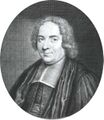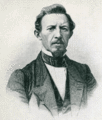Template:Selected anniversaries/December 23: Difference between revisions
Jump to navigation
Jump to search
No edit summary |
No edit summary |
||
| Line 1: | Line 1: | ||
<gallery> | <gallery> | ||
File:Pierre Varignon.jpg|link=Pierre Varignon (nonfiction|1722: Mathematician and academic [[Pierre Varignon (nonfiction)|Pierre Varignon]] dies. He simplified the proofs of many propositions in mechanics, adapted Leibniz's calculus to the inertial mechanics of Newton's ''Principia'', and treated mechanics in terms of the composition of forces. | File:Pierre Varignon.jpg|link=Pierre Varignon (nonfiction|1722: Mathematician and academic [[Pierre Varignon (nonfiction)|Pierre Varignon]] dies. He simplified the proofs of many propositions in mechanics, adapted Leibniz's calculus to the inertial mechanics of Newton's ''Principia'', and treated mechanics in terms of the composition of forces. | ||
||Baron Axel Fredrik Cronstedt | ||1722: Baron Axel Fredrik Cronstedt born ... mineralogist and chemist who discovered nickel in 1751as a mining expert with the Bureau of Mines. Cronstedt is one of the founders of modern mineralogy. Pic. | ||
||1732 | ||1732: Richard Arkwright born ... businessman and inventor, invented the Water frame and Spinning frame. | ||
||1766 | ||1766: Wilhelm Hisinger born ... physicist and chemist. Pic. | ||
File:Wilhelm Bauer.gif|link=Wilhelm Bauer (nonfiction)|1822: Inventor and engineer [[Wilhelm Bauer (nonfiction)|Wilhelm Bauer]] born. He will design and invent [[Submarine (nonfiction)|submarines]]. | File:Wilhelm Bauer.gif|link=Wilhelm Bauer (nonfiction)|1822: Inventor and engineer [[Wilhelm Bauer (nonfiction)|Wilhelm Bauer]] born. He will design and invent [[Submarine (nonfiction)|submarines]]. | ||
||Captain François Mingaud | ||1847: Captain François Mingaud dies ... infantry officer in the French army and a carom billiards player. He is credited as the inventor of the leather tip for a billiards cue, a "possibly not original idea" that he perfected while imprisoned in Bicêtre (now Bicêtre Hospital) for political outspokenness. This revolutionized the game of billiards, allowing the cue ball to be finely manipulated by the application of spin. Pic. | ||
|| | ||1900: Otto Soglow born ... cartoonist. | ||
|| | ||1907: Pierre Jules César Janssen dies ... astronomer who, along with English scientist Joseph Norman Lockyer, is credited with discovering the gaseous nature of the solar chromosphere, and with some justification the element helium. | ||
|| | ||1908: Hugo Hadwiger dies ... mathematician, known for his work in geometry, combinatorics, and cryptography. Pic. | ||
|| | ||1912: Anna J. Harrison, American organic chemist and academic (d. 1998) | ||
|| | ||1913: The Federal Reserve Act is signed into law by President Woodrow Wilson, creating the Federal Reserve System. | ||
|| | ||1923: Harold Masursky born ... geologist and senior scientist at the U.S. Geological Survey's astrogeology branch supporting space exploration. Starting in the mid 1960s, he helped analyze the photographs from the Ranger, Lunar Orbiter, and Surveyor lunar missions. In mapping the moon, suitable landing spots were being sought for the unmanned Surveyor 5 spacecraft (1967) and the manned Apollo landings (1969-72). Masursky headed the group that interpreted television transmissions from Martian satellite Mariner 9 (1971), producing maps to plan the landing of unmanned Viking spacecraft on Mars (1976). He analyzed data on the geological origins and evolution of the planets. He collaborated in foreign projects such as the Soviet Venus probes. Pic: https://www.todayinsci.com/8/8_24.htm | ||
| | ||1933: Rikitarō Fujisawa dies ... mathematician. During the Meiji era he was instrumental in reforming mathematics education in Japan and establishing the ideas of European mathematics in Japan. Pic. | ||
|| | ||1939: Anthony Fokker dies ... pilot and engineer, designed the Fokker Dr.I and Fokker D.VII (b. 1890) | ||
|| | ||1947: The transistor is first demonstrated at Bell Laboratories. | ||
File:Wilhelm Ackermann.jpg|link=Wilhelm Ackermann (nonfiction)|1948: Mathematician [[Wilhelm Ackermann (nonfiction)|Wilhelm Ackermann]] publishes his research on applications of the Ackermann function to detecting and preventing [[crimes against mathematical constants]]. | File:Wilhelm Ackermann.jpg|link=Wilhelm Ackermann (nonfiction)|1948: Mathematician [[Wilhelm Ackermann (nonfiction)|Wilhelm Ackermann]] publishes his research on applications of the Ackermann function to detecting and preventing [[crimes against mathematical constants]]. | ||
| Line 40: | Line 35: | ||
||Arthur Eichengrün (d. 23 December 1949) was a German Jewish chemist, materials scientist, and inventor. He is known for developing the highly successful anti-gonorrhea drug Protargol, the standard treatment for 50 years until the adoption of antibiotics, and for his pioneering contributions in plastics | ||Arthur Eichengrün (d. 23 December 1949) was a German Jewish chemist, materials scientist, and inventor. He is known for developing the highly successful anti-gonorrhea drug Protargol, the standard treatment for 50 years until the adoption of antibiotics, and for his pioneering contributions in plastics | ||
||Lavrentiy Pavlovich Beria | ||1953: Lavrentiy Pavlovich Beria born ... Soviet politician of Georgian ethnicity, Marshal of the Soviet Union and state security administrator, chief of the Soviet security and secret police apparatus (NKVD) under Joseph Stalin during World War II. | ||
|| | ||1954: First successful kidney transplant is performed by J. Hartwell Harrison and Joseph Murray. | ||
|| | ||1968: The 82 sailors from the USS Pueblo are released after eleven months of internment in North Korea. | ||
| | ||1972: Andrei Tupolev, Russian engineer, designed the Tupolev Tu-95 and Tupolev Tu-104 (b. 1888) | ||
|| | ||1973: Ralph Hartzler Fox dies ... mathematician. As a professor at Princeton University, he taught and advised many of the contributors to the Golden Age of differential topology, and he played an important role in the modernization and main-streaming of knot theory. | ||
|| | ||1973: Gerard Peter Kuiper dies ... astronomer, planetary scientist, selenographer, author and professor. He is the eponymous namesake of the Kuiper belt. Kuiper is considered by many to be the father of modern planetary science. Pic. | ||
|| | ||1985: Alfred Theodor Brauer dies ... mathematician who did work in number theory. Pic. | ||
| | ||1986: Voyager, piloted by Dick Rutan and Jeana Yeager, lands at Edwards Air Force Base in California becoming the first aircraft to fly non-stop around the world without aerial or ground refueling. | ||
|| | ||1989: Richard Rado dies ... mathematician whose research concerned combinatorics and graph theory. In graph theory, the Rado graph, a countably infinite graph containing all countably infinite graphs as induced subgraphs, is named after Rado. He rediscovered it in 1964 after previous works on the same graph by Wilhelm Ackermann, Paul Erdős, and Alfréd Rényi. Pic. | ||
| | ||2001: Donald Clayton Spencer dies ... mathematician, known for work on deformation theory of structures arising in differential geometry, and on several complex variables from the point of view of partial differential equations. | ||
||2013 | ||2013: Mikhail Kalashnikov dies ... Russian general and weapons designer, designed the AK-47 rifle. | ||
||2014 | ||2014: Robert V. Hogg, American statistician and academic. | ||
||December 23 is the fictional date of the [[Zendian problem (nonfiction)|Zendian problem]], a US Army cryptography training exercise involving 375 radio messages said to have been intercepted on December 23 by the US Army contingent of a United Nations force landed on the fictional island of Zendia in the Pacific Ocean. | ||December 23 is the fictional date of the [[Zendian problem (nonfiction)|Zendian problem]], a US Army cryptography training exercise involving 375 radio messages said to have been intercepted on December 23 by the US Army contingent of a United Nations force landed on the fictional island of Zendia in the Pacific Ocean. | ||
</gallery> | </gallery> | ||
Revision as of 16:45, 17 August 2018
1722: Mathematician and academic Pierre Varignon dies. He simplified the proofs of many propositions in mechanics, adapted Leibniz's calculus to the inertial mechanics of Newton's Principia, and treated mechanics in terms of the composition of forces.
1822: Inventor and engineer Wilhelm Bauer born. He will design and invent submarines.
1948: Mathematician Wilhelm Ackermann publishes his research on applications of the Ackermann function to detecting and preventing crimes against mathematical constants.


